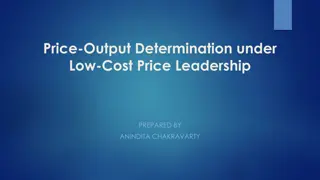Understanding the Marketing Mix: Product, Price, Promotion, and Place
The marketing mix refers to the tactics used by a company to promote its brand or product, including the 4Ps - Product, Price, Promotion, and Place. It also encompasses other elements like Packaging and People. Understanding customer needs, pricing strategies, and effective communication are key components of a successful marketing mix.
Download Presentation

Please find below an Image/Link to download the presentation.
The content on the website is provided AS IS for your information and personal use only. It may not be sold, licensed, or shared on other websites without obtaining consent from the author. Download presentation by click this link. If you encounter any issues during the download, it is possible that the publisher has removed the file from their server.
E N D
Presentation Transcript
Dr. I. ASHIQ MOHAMED Assistant professor JMC, Trichy.
Definition The marketing mix refers to the set of actions, or tactics, that a company uses to promote its brand or product in the market. The 4Ps make up a typical marketing mix - Price, Product, Promotion and Place. However, nowadays, the marketing mix increasingly includes several other Ps like Packaging, Positioning, People and even Politics as vital mix elements.
Meaning The term 'marketing mix' is a foundation model for businesses, historically centered around product, price, place, and promotion (also known as the "4 Ps"). The marketing mix has been defined as the "set of marketing tools that the firm uses to pursue its marketing objectives in the market . Thus the marketing mix refers to four broad levels of marketing decision: product, price, place, and promotion.
The product is seem to meet a specific customer need or demand. All products follow a logical product life cycle anvarious stages and their unique challenges. It is key to understand those problems that the product is attempting to solve. The benefits offered by the product and all its features need to be under need to be studied. In addition, the potential buyers of the product need to be identified and understood.
Price covers the actual amount the end user is expected to pay for a product. How a product is priced will directly affect how it sells. This is linked to what the perceived value of the product is to the customer rather than an objective costing of the product on offer. If a product is priced higher or lower than its perceived value, then it will not sell. This is why it is imperative to understand how a customer sees what you are selling. If there is a positive customer value, than a product may be successfully priced higher than its objective monetary value. Conversely, if a product has little value in the eyes of the consumer, then it may need to be underpriced to sell. Price may also be affected by distribution plans, value chain costs and markups and how competitors price a rival product.
The marketing communication strategies and techniques all fall heading. These may include advertising, sales promotions, special offers and public relations. Whatever the channel used, it is necessary for it to be suitable for the product, the price and the end user it is being marketed to. It is important to differentiate between promotion. Promotion communication aspect of the entire marketing function. under the promotion marketing is and the just
Place or placement has to do with how the product will be provided to the customer. Distribution is a key element of placement. The placement strategy will channel is the most suited to a product. How a product is accessed by the end user also needs to compliment the rest of the product strategy. help assess what























